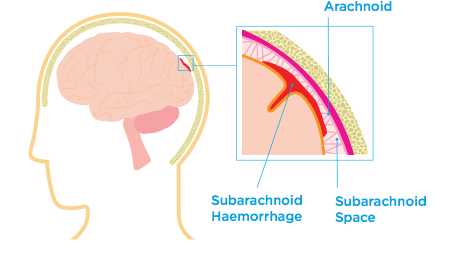Strokes and haemorrhages are one of the biggest causes of Acquired Brain Injury. A stroke happens when a blood vessel in, or around, the brain bursts or is blocked. This causes damage to the brain cells. A Haemorrhage is a bleed. There are two main types of strokes – Ischaemic Stroke and Haemorrhagic Stroke.
A Haemorrhagic Stroke is also known as a Brain Haemorrhage. Together, strokes and haemorrhages account for approximately half of all acquired brain injuries.
Ischaemic Stroke
An Ischaemic Stroke is caused when a blood vessel supplying the brain becomes blocked. Brain cells become deprived of oxygen and eventually stop working. About 85% of all strokes are ischaemic.
What causes an Ischaemic Stroke?
- A common cause is hardening and narrowing of the arteries. This is known as Atherosclerosis.
- Another cause of an ischaemic stroke is when a blood clot forms in the heart and travels up to the brain. This can happen due to a heart attack, problems with the heart valves or an irregular heartbeat. A condition known as Atrial Fibrillation can cause an irregular heartbeat.
- Other causes of an ischaemic stroke include the use of illegal drugs, a traumatic injury to the blood vessels in the neck or medical conditions that make the blood clot too easily.

Brain Haemorrhage (Haemorrhagic stroke)
A Brain Haemorrhage is sometimes called a ‘brain bleed’. A haemorrhage happens when there is bleeding in, or around the brain because of a burst blood vessel. Brain haemorrhages make up about 15% of all strokes. There are two main types:
- A Subarachnoid Haemorrhage happens when a blood vessel bursts in the area between the brain and its protective layers, the meninges. This area is known as the Subarachnoid Space.
- An Intracerebral Haemorrhage happens when a blood vessel bursts inside the brain itself.
Subarachnoid Haemorrhage

What causes a Brain Haemorrhage?
Conditions and events that affect the blood vessels can cause a brain haemorrhage. These include:
- Uncontrolled high blood pressure (known as Hypertension).
- An Arteriovenous Malformation (AVM). This is an abnormal tangle of blood vessels that some people are born with. The walls of the blood vessels are thin, and this can lead to bleeding in the brain if they burst.
- An Aneurysm . This is a weak spot on an artery that has bulged out. The walls of an aneurysm can burst because they are thin and weak from being stretched. Some people are born with an aneurysm; others may develop one during their lifetime. Some factors that increase the risk of developing an aneurysm are smoking, high blood pressure, a family history of aneurysms and using illegal drugs.
- A brain haemorrhage can also happen if medications taken to prevent the blood from clotting are poorly controlled. These medications are known as Anticoagulants.
- Illegal drugs, such as cocaine, can irritate the walls of blood vessels in the brain. This makes the walls weaker and more likely to burst.
- A traumatic brain injury can also cause a brain haemorrhage.
A ‘Mini-stroke’ or TIA (Transient Ischaemic Attack)
A TIA happens when blood flow to part of the brain stops for a short while. It can have similar symptoms to a stroke, but the symptoms may disappear after a few minutes. A TIA is a serious warning sign that the person affected may have a stroke in the future.
Symptoms of a TIA can include weakness on one side of the body or face, slurred speech, blurred vision, severe headache or confusion. If you experience any of these symptoms you should go to your GP, or Accident and Emergency Department, without delay.